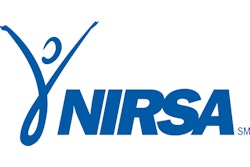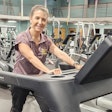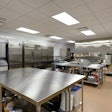The good intentions of architects and clients have gotten even better, but sports and recreation facilities remain a challenge for proponents of sustainable design.
 Photo of a stadium full of cheering fans
Photo of a stadium full of cheering fans
By their very nature, recreation centers and spectator facilities pose a problem for the green movement. Their big footprint is a great big carbon footprint, requiring tons of steel, concrete and other materials that must be transported during construction. Both have the potential - in showers, restrooms, concessions operations and pools, and on fields and landscaping - to be enormous guzzlers of water. Rec centers feature large volumes (atriums, natatoriums, gymnasiums) that come with huge air-handling requirements, encompass energy hogs such as pools and ice rinks, and utilize large expanses of glass that can add significantly to the building's heat load. Stadiums and arenas likewise burn energy like there's no tomorrow, and create mountains of trash besides.
Still, operators and designers have not shied away from the challenge these facilities pose. Far from it, in fact - driven by state regulations and forward-looking administrators and end users, environmental consciousness in sports and recreation facilities is nowadays the rule, not the exception. These advances in sensitivity have been matched by advances in technology, to the point where you could say that achieving sustainability is now mainly a matter of will. Well, that and money - in spite of all the innovation, it still takes dollars up front, and a wager that the lion's share of savings will come farther down the road.
LEED, or "Leadership in Energy and Environmental Design," is a well-built acronym. Its terminology celebrates sustainability as an ongoing preoccupation, not as the last word. Although there is a recognizable hierarchy (platinum at the top, then gold, silver and "certified" at the bottom) based on accumulated points awarded for implementing certain sustainability practices, you've achieved leadership by reaching any of the four levels - the state of the art as of this moment, whatever the future may hold.
This nuanced approach appears lost on many of the people whose buildings have attained LEED, and, probably, on most of those facilities' users. When referenced as a kind of green "seal of approval," it tends to rankle dyed-in-the-wool environmentalists, who are liable to express reservations about its use as a marketing tool as well as for setting the bar (in their opinion) too low. Indeed, it makes for an easy mark, says Colleen McKenna, a senior associate at Cannon Design in Boston. "Some of it's so basic, like 'Get a bicycle rack. Provide a changing room. Use low-VOC carpets.' Well, duh," McKenna says. "This is what the critics of LEED say: 'There shouldn't even be a point for that.'"
Another sticking point surrounds the high costs involved. "Most architects charge an additional service fee to do the substantial paperwork required," notes Erik Kocher, a principal with Hastings & Chivetta Architects in St. Louis. "Also, some time after the building is completed, mechanical engineers have to run an analysis of the building to ensure it's operating at the appropriate design level. I've seen estimates of half a percent of the project cost for third-party commissioning, and at that rate it can start at $100,000 to $150,000 to get a plaque. Of course, it looks good from a marketing standpoint; you can put the plaque in your lobby."
 Aerial Photo of the Charles Hostler Student Center at American University of Beirut
Aerial Photo of the Charles Hostler Student Center at American University of BeirutEven if the plaque is window-dressing, what it honors is more like a foundation, in the view of Ana Serra, an associate and sustainability consultant with New York-based Buro Happold Consulting Engineers. "Certainly, LEED is a good framework to follow," Serra says, though adding that most of her projects follow the framework and eschew the plaque. "It covers all the important issues that need to be addressed if a project has any sort of sustainability agenda."
Kocher agrees, estimating that 70 percent of those issues are basic tenets of design. "Good architects are more than halfway there by doing quality architecture, insulating the building carefully, orienting it well," he says. "We've been doing it for years, we just couldn't get points for doing it. Now you can get points - if you want to pay for them."
As Vincent James Associates Architects of Minneapolis has definitively shown, others besides the U.S. Green Building Council will take notice of your sustainability efforts. Two of VJAA's recently completed facilities were named Top Ten Green Projects by the American Institute of Architects Committee on the Environment (AIA/COTE) - Tulane University's Lavin-Bernick Center for University Life in 2008 and the Charles Hostler Student Center at American University of Beirut in 2009.
In the Tulane project, a 142,000-square-foot adaptive reuse of an existing student center, the firm transformed a building that had been mechanically cooled year-round into a facility that is now passively cooled five months out of the year. By reusing the existing 112,000-square-foot, three-story concrete frame structure of the original, costs and resource use were reduced, while building components were reorganized so that spaces that must utilize mechanical cooling (such as an auditorium) are now located in the building's center. Light wells were placed to bring daylight deep within the facility, and a number of passive cooling strategies - water walls, wave fans in the dining room, solar vents on the interior, and sun-shading louvers on the exterior - help keep energy costs down. "Basic planning aspects should not cost additional money," says Paul Yaggie, a VJAA senior associate, who has not yet been through the LEED process. "It's just smart design."
The Hostler Center, this year's VJAA winner, features a gymnasium, a natatorium, squash courts, a fitness center and a track-and-field facility, and utilizes many of the same passive strategies. As with the Tulane project, an early design decision was crucial - although the university was wedded to the idea of a single large-scale building and similarly scaled open plaza, the designers insisted the facility be constructed as separate structures organized around a network of radial "streets" and woven together by a series of courtyards, circulation paths and spectator areas. As a result, winds from the nearby oceanfront are channeled up through the cluster of facilities and used for passive cooling. The list of active green strategies utilized is also extensive, including roof-integrated solar collectors for hot water and swimming pool heating, a radiant slab cooling system and a high-efficiency chilled water generation plant that uses on-site wells for system cooling.
 Photo of the Charles Hostler Student Center gymnasium at American University of Beirut
Photo of the Charles Hostler Student Center gymnasium at American University of BeirutHowever, even these more exotic sustainability efforts are commonsense in light of the facility's location. As McKenna says, "The drawback to designing six little boxes instead of one big box is you're basically buying much more exterior wall, and traditionally speaking, each of the six boxes needs its own systems to support it. It's not as efficient. On the other hand, if you break the sports components down into smaller boxes you may be able to get more natural ventilation flowing through the site, or better solar orientation. If you're on the Mediterranean, it might work; in Iowa, the climate is pretty rough in the winter."
The key to smart sustainable design, then, is the same as with smart design in general - using what the location and site have to offer. The Hostler Center's smaller buildings therefore follow an east-west orientation, helping shade exterior courtyards and reducing the amount of southern exposure, while the end walls face the north-south prevailing winds to allow maximum air circulation through the buildings. In full, 60 percent of the spaces are naturally ventilated.
Two current Buro Happold soccer stadium projects (as this was written, the names were being withheld by the company) demonstrate the point. One is located in South America, in a tropical region where there is a lot of rainfall, while the other is located in an arid climate in South Africa. "There's no formula for stadia that would apply for all of them," Serra says. "On the South American project I had more water than I could use, so we had to create water features outside that could accommodate the peaks of rain events, and on the South African one, we barely had enough water, so we had to sort of recycle and grab water from various places to meet the demand for the project. The issues are always the same, but the variable is what's available where the project is located."
Cannon's work on Bermuda National Stadium brought up similar issues. With no water source absent collected rainwater, huge on-site collection, storage and filtration systems were a necessity. Water that percolated through the natural turf, for example, was collected and recycled using 9-foot-diameter pipes running underneath the field. Now, the firm is investigating solar collection to offset the cost to heat the pool water at Worcester Polytechnic Institute; the only problem is whether the amount of sunlight in Massachusetts will allow it to make sense. "The payback on a solar collection strategy in Arizona is going to be very different than it is here," McKenna says. "It's kind of iffy in this region, and it's a big expense. In Arizona, why wouldn't you do it?"
The more unconventional the sustainability strategy, the more important payback becomes. "When you start getting pricey, a lot of stuff gets value-engineered out," McKenna notes. "You're trying to balance first cost with lifecycle cost, and when you get to a point where the payback is 20 years, a lot of people don't think that's quick enough. If it's a $100,000 item, in today's economy? Some people would say you're trading program space for a sustainable strategy."
 Photo of the Charles Hostler Student Center pool at American University of Beirut
Photo of the Charles Hostler Student Center pool at American University of BeirutVJAA's design of the solar-collection system in Beirut tried to anticipate future technological improvements by keeping electrical tie-ins and the solar panels themselves accessible, so they might one day be switched out for more-efficient panels. But the firm and the client didn't hesitate to commit to that added expense.
"When solar panels are coupled with a pool, I think they have much quicker realization," Yaggie says. "You're dealing with something that's an incredibly large load, and you're doing a lot better with operational costs when you can contribute to that overall load proportionately."
Other expensive first-cost items include geothermal wells, vegetative roofs and wind power, and none have yet proven to be particularly effective on buildings as large as 200,000-square-foot recreation centers. Geothermal's benefits are documented, but primarily in residential settings (the U.S. Environmental Protection Agency says geo-exchange systems save homeowners 30 to 70 percent in heating costs, and 20 to 50 percent in cooling costs, compared to conventional systems). Onsite wind power (as opposed to wind farms) got a public-relations bump in 2007 with the installation of three wind turbine blades between the twin skyscrapers of the Bahrain World Trade Center, but as Serra says, "It's sort of an iconic statement that says, 'This is a green building,' but if you see how much power they generate, it's often less than 1 percent, and they don't really pay for themselves."
Vegetative roofs are similarly symbolic, but their weight makes them problematic over large spans and adds significantly to structural engineering costs. Plus, says Fred Thurston, a partner with Forefront Design in Rapid City, S.D., they work better in some locations than others. "We have a dry climate, so it doesn't work very well here," he says, "and there are other ways of achieving the same thing that I think are more cost-effective. There are other ways of reusing stormwater, and the heat island effect can be dealt with effectively by using white roofs with a high reflective value."
Thurston, who lives in a passive solar home he designed 27 years ago (his thesis, which he completed back in 1973, was on sustainable design), incorporated many simple daylighting and energy-saving features into the exterior of Rapid City Community Center West and South. These included light shelves, which reflect indirect light deeper into facilities, and heat-absorptive panels, which preheat air entering the building's circulation system (see "Design Details,"). Thurston maintains that the lion's share of sustainability efforts will take this simpler approach, just because architectural history suggests it will.
 Photo of an entryway to the Charles Hostler Student Center at American University of Beirut
Photo of an entryway to the Charles Hostler Student Center at American University of Beirut"If you look at historic buildings, the windows were double hung so you could open the bottom and top to get natural circulation as the heat dissipates out and fresh air comes in the bottom," Thurston says. "The buildings were designed generally narrow so you could get light in both sides. Architects designed buildings that way because they had to; they didn't have electricity and the lighting we have today."
It is a great irony that it has been difficult to incorporate environmentally healthy building systems into facilities devoted to physical fitness and wellness. The intensifying focus on building green is making this easier to accomplish, even as the proliferation of products and equipment makes attaining sustainability seem infinitely more complicated.
Further confusing the matter is that the functions of each building system, and the technologies that serve each, are interconnected. So, daylighting is made more environmentally feasible by advances in insulated glass, which leads to even more energy-saving products, such as lighting controls that automatically adjust to ambient light levels. Added glass also means more heat from sunlight, however, which leads to the incorporation of building fans and other destratification equipment, and building-exterior shading.
The simplest aspect of sustainability - awareness - has largely been achieved, from architects to contractors to product manufacturers to building operators to end users.
"How contractors deal with basic construction waste has changed completely, and it's a valuable thing," Kocher says. "That stuff never got recycled 15 years ago; it just went into a dumpster and was taken to the landfill. A lot of manufacturers now really cut down on the amount of packaging, and almost all of that can be recycled, too."
All but one of Hastings & Chivetta's professional staff members are LEED professionals, and as the firm works primarily in collegiate recreation, they come to the office knowing they're grappling with what has long been college campuses' least-efficient facility. Times have changed, though, for the better.
"Because rec centers operate 18 hours a day, have tons of people in them, and have huge exhaust and lighting requirements, they're an unusual animal when it comes to being sustainable," Kocher says. "If all you wanted was to save energy, you could always go back to the 1970s model, which is low ceilings, no windows, heavily insulated walls and reduced program space. Before there was LEED and we had an energy crisis, that was the response. Those were horrible buildings. One of the nice things about LEED is that it takes into consideration the experience of the user, emotionally as well as physically, which is why these buildings have transparency, natural light, all those other things that add to users' enjoyment of the space. It's a whole-person approach."




































